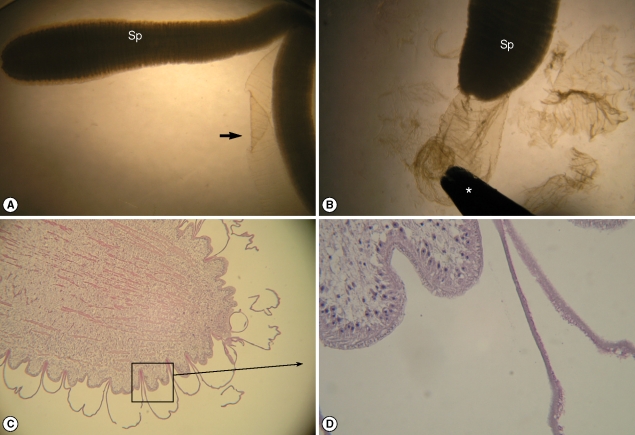Abstract
The tegument of tapeworms is known to be composed of an outer syncytial cytoplasm layer which includes microtriches and cytoplasmic organelles (= syncytial layer), and a parenchymatous cytoplasm layer that contains subtegumental cell nuclei (= subtegumental layer) and organelles. In the present study, separation of the syncytial layer of the sparganum, the plerocercoid stage of Spirometra mansoni, was tried using urea as the chemical reagent. Histological sections were prepared to visualize the status of separation after staining with hematoxylin and eosin. The results showed that the syncytial layer of the sparganum tegument which includes microtriches and cytoplasmic organelles were successfully separated from the parenchyma using 3 M urea.
-
Key words: Spirometra mansoni, sparganum, tegument, syncytial layer, urea
Human sparganosis is a tissue-invading disease caused by the sparganum (= plerocercoid of
Spirometra mansoni) that utilizes intermediate hosts such as snakes and frogs, and is not uncommon among the people in Korea [
1]. After ingested by the intermediate hosts, the sparganum penetrates the intestinal wall and migrates to the peritoneal cavity within a few hours. Subsequently, the worms move to subcutaneous tissues or other organs where they form a parasitic granuloma.
A characteristic feature of the tegument of Class Cestoda tapeworms is that it participates in the absorption of nutrients, excretion of waste metabolites, and protection from host digestive enzymes [
2-
4]. Ultrastructurally, the tegument of spargana is covered with numerous microtriches and glandular cells used for migration of the worm in the host [
5,
6]. This tegument is involved in initial antigenic contact with the host. Appropriately, potent antigenic molecules for host-generated antibodies are located in the outer layer of spargana [
7]. In seeking an antibody-mediated preventive strategy for sparganosis, acquisition of the pure tegument or a part of the tegument, for example, the syncytial layer would be advantageous. The present study was performed to selectively separate the syncytial layer of the tegument using a high concentration of urea.
Spargana were collected from subcutaneous tissues of naturally infected snakes in Korea. After washing with sterile physiologic saline, the worms were stored at 4℃ until used to infection. Spargana from snakes were infected orally to BALB/c mice. After 1 month, infected mice were killed and spargana were collected from the subcutaneous tissues. Worms were individually added to a culture dish containing RPMI medium supplemented with 3 M urea, 1 mM EDTA, and 30% (v/v) fetal bovine serum. After incubation at 37℃ for 3 hr, spargana was fixed in 10% neutral buffered formalin and the fixed worms were processed by routine histological procedures followed by staining with hematoxylin and eosin. All reagents used in this study were purchased from Sigma-Aldrich (St. Louis, Missouri, USA).
Initially an effective urea concentration was identified. At 1 M urea, worms were still active and separation of the syncytial layer did not occur. At least 2 M urea was needed to achieve a successful separation (data not shown). Separation of the syncytial layer from the parenchyma of spargana was evident beginning from 1 hr after incubation in 3 M urea and the separation continued until 3 hr of observation (
Fig. 1A). At 3 hr after incubation, the syncytial layer was easily collected by rolling or scratching the sparganum using a syringe needle or a micro-forcep (
Fig. 1B). Hematoxylin and eosin staining demonstrated a clear separation of the syncytial layer of the tegument from the parenchyma (
Fig. 1D).
Urea is a commonly used chemical denaturant of proteins, and is well established to be a tool for the study of biological membranes. Generally, protein solubility increases with increasing urea concentrations [
8]. Although precise details of ureamediated separation of the syncytial layer remain unknown, it is conceivable that it may involve the ready permeation of the uncharged, low molecular weight urea through the syncytial layer and solubilization of proteins anchoring the syncytial layer on the parenchymal layer of the sparganum.
Serologic diagnosis of human sparganosis relies on ELISA [
9] or immunoblot [
10] detection of host serum antibodies. Various kinds of antigenic proteases are known to be present in the sparganum. They include excretory-secretory proteins with a molecular weight of 31/36 kDa [
11], 27 kDa cathepsin S-like protease [
12], and 53 kDa neutral protease [
13]. These proteases, which are secreted from the tegument of spargana, potently influence host immune processes that include IgG degradation and specific IgE responses [
12,
13]. In this respect, studies of the tegumental layer of Class Cestoda tapeworms have focused on the ultrastructure of specific structures like microtriches [
6]. The present study offers the means of separating the syncytial layer of the tegument, which opens a door for specific studies of the tegument physiology and antigenicity.
ACKNOWLEDGEMENTS
The author thanks Mr. Je-Young Ryu for his technical assistance. The research was supported by grants from the Tropical and Endemic Parasitic Diseases Control Programme of the National Institute of Health (NIH 347-6111-211), Ministry of Health and Welfare, Republic of Korea.
References
Fig. 1Photographs of the syncytial tegument separation from the parenchyma of a sparganum (Sp) after exposure to 3 M urea. Appearances at 1 hr (A) and 3 hr (B) after incubation. Both images are at a magnification of ×15. Note that the posterior portion (A: arrow) of the sparganum was easily separated at 1 hr (A) and that the detached layer could be collected using a micro-forcep (B: asterisk). Images (C and D) obtained after hematoxylin and eosin staining which demonstrate clear separation of the syncytial layer of the tegument at ×40 magnification (C) and at ×200 magnification (D).

Citations
Citations to this article as recorded by

- Electron Microscopy of the Separated Outer Tegument of the Sparganum and Its Antigenicity
Hyun-Jong Yang
The Korean Journal of Parasitology.2012; 50(2): 181. CrossRef - Production of Polyclonal Antibodies against the Tegument of Sparganum (Plerocercoid of Spirometra mansoni) and Its Immunolocalization
Hyun-Jong Yang
The Korean Journal of Parasitology.2010; 48(2): 183. CrossRef


